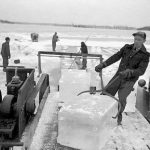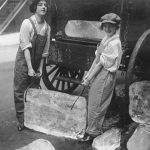 Before the 1830’s, food was preserved by salting, spicing, pickling or smoking. The people back then had no refrigerators, so butchers slaughtered meat only for the day’s trade, as preservation for longer periods was not practical unless you made jerky or something. Dairy products and fresh fruits and vegetables subject to spoilage were sold in local markets since storage and shipping farm produce over any significant distance or time was impossible. Milk was often hauled to city markets at night when temperatures were cooler. Ale and beer making required cool temperatures, so its manufacture was limited to the cooler months. The solution to these problems was found in the harvesting of natural ice.
Before the 1830’s, food was preserved by salting, spicing, pickling or smoking. The people back then had no refrigerators, so butchers slaughtered meat only for the day’s trade, as preservation for longer periods was not practical unless you made jerky or something. Dairy products and fresh fruits and vegetables subject to spoilage were sold in local markets since storage and shipping farm produce over any significant distance or time was impossible. Milk was often hauled to city markets at night when temperatures were cooler. Ale and beer making required cool temperatures, so its manufacture was limited to the cooler months. The solution to these problems was found in the harvesting of natural ice.
Before the invention of refrigerators in the early twentieth century, ice was harvested every winter from the lakes and stored in large ice houses, the proprietors then sold the ice to shippers of fresh fish, waterfowl, and produce for train deliveries to large cities. The ice harvesting process was labor intensive, requiring 20-100 men for one to four weeks. I suppose it was good temporarily, but was not permanent work.
Nineteenth-century ice harvesting began well before the actual cutting. As soon as the ice was strong and thick enough to support horses and equipment, work forces cleared away the insulating snow, sometimes many times, if necessary, to encourage the formation of stackable, thicker blocks. When the ice was thick enough, the field was marked in squares, using a horse-drawn marker, which scored slightly deeper into the ice, and finally the blocks were cut by hand with the use of large-toothed one-man saws. The blocks were then floated to the large adjacent commercial ice house for stacking, or to a railroad loading ramp for shipping. The system worked pretty well, and lasted throughout the century, the major change being the late introduction of rotary saws that replaced hand-cutting, making the job much easier.
The latter half of the 19th century saw many attempts to perfect manufactured ice methods. The Louisiana Ice Manufacturing Company appears to have been the first one to operate regularly, one of its claims being a price considerably lower than that of natural ice. Others followed. By 1925 factory-made ice had entered the realm of big business, and natural ice had become a thing of the past…just like that. In the 19th century commercial ice houses were constructed to provide ice for general use, to stock private ice houses when supplies from the local pool were scarce and later to produce “frozen” food. Some of these ice house’s were really a barn within a barn, with 3 feet of sawdust and hay between the inner and outer walls. City dwellers had ice delivered to them by horse and wagon. The iceman had to lift from 25 to 100 pound blocks, according to the order, which was placed by the consumer putting a numbered card in the window that corresponded with the number of pounds of ice they wanted. The ice was weighed on a spring scale on the truck, but an experienced delivery man could estimate the weight. The ice was carried to a kitchen using ice tongs, and chipped with chisels to fit the compartment of the ice box.
Delivery men were known for their brawn, as they hauled heavy blocks of ice all day long, and often up flights of stairs. Nevertheless, occasionally two women teams delivered the ice. They often had access to the kitchen when no one was home, and they simply placed the ice appropriately. Some city apartments used a suspended box (a small version of the ice box) outside the kitchen window, its contents available to the cook through the raised window; others kept an ice chest outdoors on the porch, or a handsome oak refrigerator in the kitchen. Ice wagons were great for children playing in summer’s heat. They loved when the iceman dropped his ice tongs and used his ice pick to chop a small piece of ice for them to suck on, similar to today’s ice cream trucks.

Residential ice boxes, many home-made, were of oak, pine, or ash wood lined with zinc, slate, porcelain, galvanized metal or wood. The insulator between the walls was charcoal, cork, flax straw or mineral wool. Still, the ice lasted only one day. Wooden boxes lined with tin or zinc and insulated with various materials including cork, sawdust, and seaweed were used to hold blocks of ice and “refrigerate” food. A drip pan collected the melt water…and had to be emptied daily. Electric refrigerators and freezers seriously hurt the ice industry. Although the first models were marketed before 1920. It would be a while before everyone had them, so ice delivery continued to be used, but declined yearly.


Leave a Reply